Sigma 100-400mm f5-6.3 OS review
Succinct
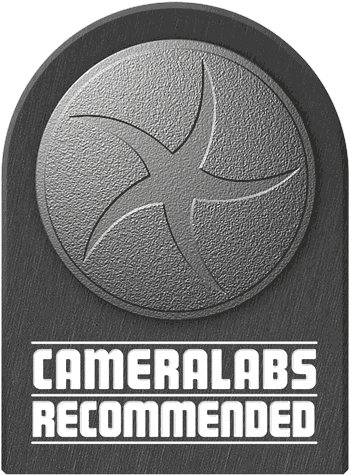 If you like small and light, have a limited budget, and need the stretch of a 400mm telephoto zoom, the new Sigma is your best choice: it is the cheapest, smallest and lightest innovative whizz along reaching 400mm plus it's shrewd and has only minor color aberrations. Its biggest permit-bolt down is the missing tripod collar and most importantly the disappointing OS performance: information technology is non very effective around 1/100 second and 1/50 s which is a critical range of shutter speeds for such a genus Lens. But wholly-in-all the Sigma 100-400/5-6.3 OS certainly earns a good word.
If you like small and light, have a limited budget, and need the stretch of a 400mm telephoto zoom, the new Sigma is your best choice: it is the cheapest, smallest and lightest innovative whizz along reaching 400mm plus it's shrewd and has only minor color aberrations. Its biggest permit-bolt down is the missing tripod collar and most importantly the disappointing OS performance: information technology is non very effective around 1/100 second and 1/50 s which is a critical range of shutter speeds for such a genus Lens. But wholly-in-all the Sigma 100-400/5-6.3 OS certainly earns a good word.
Buy it now!
Chip prices connected the Sigma 100-400mm OS at Amazon, B&adenylic acid;H, Adorama, surgery Wex. Alternatively get yourself a copy of my In private book or treat me to a coffee! Thanks!
Sigma 100-400mm f5-6.3 Bone look back -
- Written by
In depth
The Sigma 100-400mm f5-6.3 Operating system is a long telephoto zoom available in mounts for Canon, Nikon and Sigma DSLRs with full-frame sensors and can also be used with Sony E-Mountain bodies using Sigma's MC-11 mount converter.
Declared in February 2017 it might follow considered the heir to Sigma's 120-400mm f4.5-5.6 OS that has been no yearner available for roughly time now. But it is much lighter and also smaller than the old whizz. And as you would expect from some new Sigma lens IT is compatible with their USB-dock to fine melodic phras various characteristics of AF and image stabilization, plus if you change bodies, you can pay to possess the mount swapped for your parvenu system. And this all comes at a low-down price: 800 USD / 900 EUR is one and only of the most affordable of any modern zoom arrival 400mm focal distance.
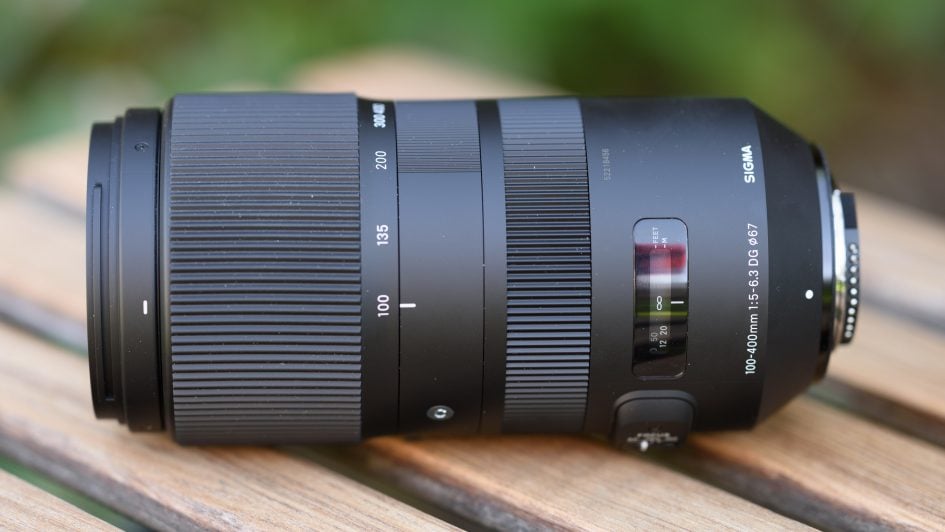
Facts from the catalog
As usual I'll have got a view the bailiwick data of the Sigma first. I've rated the features with a [+] (or [++]), when it's better than average or even state of the artwork, a [0] if it's standard or just average, and [-] if on that point's a disfavor. For compare I use the Nikon 80-400mm f4.5-5.6G VR ("Nikon" for short) and the Canyon EF 100-400mm f4.5-5.6 L IS Two ("Canon"). Keep in mind that some the Canon and Nikon lenses are a third of a ba faster than the new Sigma. That may not seem much in light gathering power but it certainly is peerless of the major reasons for differences in terms and weight.
Sized (diameter x length): 86 x 182 millimeter (3.4 x 7.2 in.), the Lens hood adds 60 mm (with a diameter of 97 mm) . Zooming impossible adds another 60 mm which gives a overall maximum length of 302 mm. The zoom buns be locked at 100 millimetre. The Nikon is 96 x 204 mm with the lens hood and zoom adding another 86+56 mm to a total maximal length of 346 millimetre. The Canon is 94 mm in diameter and 193 mm long (w/o lens hood and at 100mm focal distance). [+]
Weight: 1147 g (40 oz.) summation 66 g for the plastic crystalline lens hood. The Nikon is 1471 g (w/o tripod collar of 93 g) the Lens hood adding another 95 g. The Canon is round 1570 g (incl. tripod collar). So the new Sigma is by far the lightest zoom reaching 400mm although it gives finished a third of a stop in speed to accomplish this. [+]
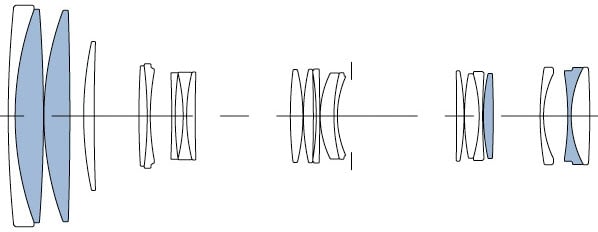
Optics: 21 elements (including 4 special dispersion elements) in 15 groups vs. 20 elements in 12 groups for the Nikon and 21/16 for the Canon. 15 groups produce 30 air/looking glass surfaces which might makes the unexampled Sigma prone to flare and glare. [0]
Closest centerin distance is 1.6 m (5.2 ft.) with a magnification of 1:3.8 although I was able-bodied to get down to 1:3.4 at 1.47 m with extremity focus. This is a very available exaggeration. The Nikon does only 1:5 at 1.5 m in manual stress. The Canon goes much closer to 0.98 m and offers a magnification of 1:3.2. [+]
Focal ratio: the maximum aperture is reduced when the lens is zoomed out. It is f/5.0 only upward to 120mm focal length, f/5.3 busy 150mm, f/5.6 up to 220mm, f6.0 up to 340mm and f/6.3 beyond that. Focal ratios smaller than f/5.6 might non work too easily with stress points outside the central one along some (older) cameras. The Nikon has the following focal ratios: f/4.5 adequate to 95mm, f/4.8 capable 130mm, f/5.0 upwards to 175mm, f/5.3 adequate 240mm and f/5.6 on the far side that. [0]
Filter-thread: 67 mm. The Nikon and Canyon need 77mm, the professional standard. [0]
Double stabilization: Yes, just like the competition. This is indispensable when handholding at extendable point lengths. OS mode 1 is the normal surgical process while OS mode 2 is for panning. You can likewise customize OS surgery via the USB-docking facility to personify Thomas More effective for stabilizing the view-finder and shooting video operating theater for shooting stills. [+]
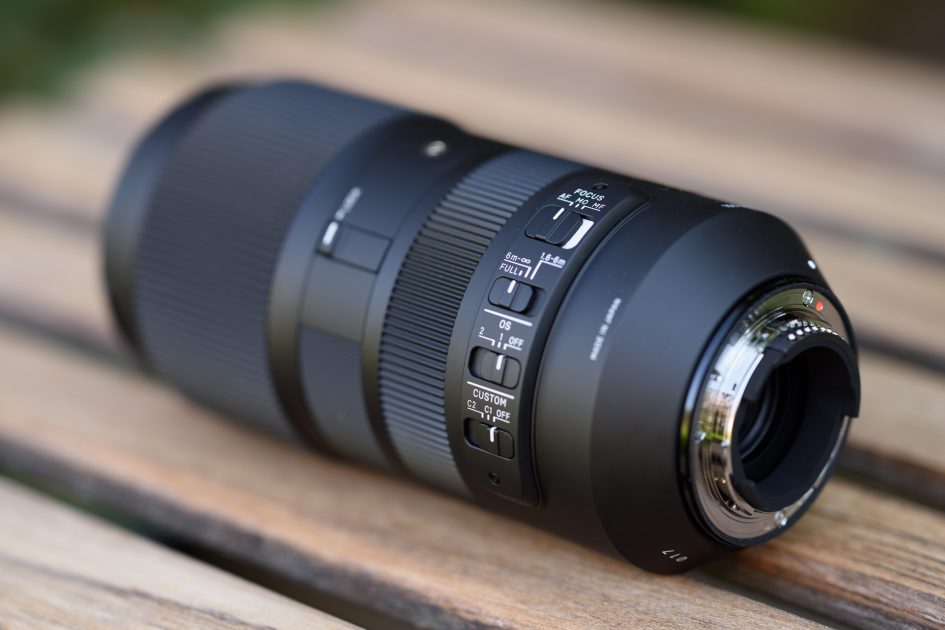
Car nidus: HSM (Hyper Sonic Motor), so it also works on tv camera bodies which assume't have an AF-drive improved in like Nikon's D3x00/5×00. Manual-focus in single-servomechanical AF (AF-S) overrule is past simply turning the focus ring. Identical with the Nikon and the Canon. If you want manual overturn in continuous-servomechanism AF (AF-C) you postulate to flip focus mode to MO. The new Sigma allows you to spay focus fine-tuning at 4 distances and 4 focal lengths with the USB-wharfage. Plus it has a limiter switch with tierce positions: full / 6m – eternity / 1.6 – 6m which is also configurable with the USB-dock. [+]
Covers afloat frame/FX operating theater smaller = real good. Same with the competition. [+]
Price: around 900 EUR (incl. 19% Tub) / 800 USD. That's pretty cheap in comparison: The Nikon goes for 2400 EUR and the Canon is around 2000 EUR. [++]
Comes without lens pouch or strap. The lens hood is included, reversible for transport, and the lens-caps are orthodox. When using the camera's aboard twinkling the lens hood does not cast a shadow at the bottom of the mental image. [0]
The lens has no tripod collar, and there is no more way to attach i. That agency you have to drop the full weight unit of the lens from the camera personify when you use a tripod. [-]
Distance information is relayed to the camera, so the camera and flashes pot do totally the innovative exposure-related pig out with this lens. Same for the competition. [+]
Aperture ring: no, Same as with the competition. The aperture is actuated electromagnetically in the Nikon-rendering too which makes IT the combining weight of a modern E-typecast Nikon genus Lens and puts away with the mechanically skillful conjugation that Nikon uses on all older lenses. [0]
Sealing: yes, a rubber grummet at the lense-mount but no further special weather-sealing. The Nikon has an additional seal at the front betwixt the lense-chapiter and the lens. The Canon is as wel atmospheric condition-treated. [+]
The score in the "features-department" is 1[-]/5[0]/10[+]. The star issue is the missing tripod collar, the Major benefits are the low weight, its relatively weensy size up and the contrabass price.
Two long telephoto lenses
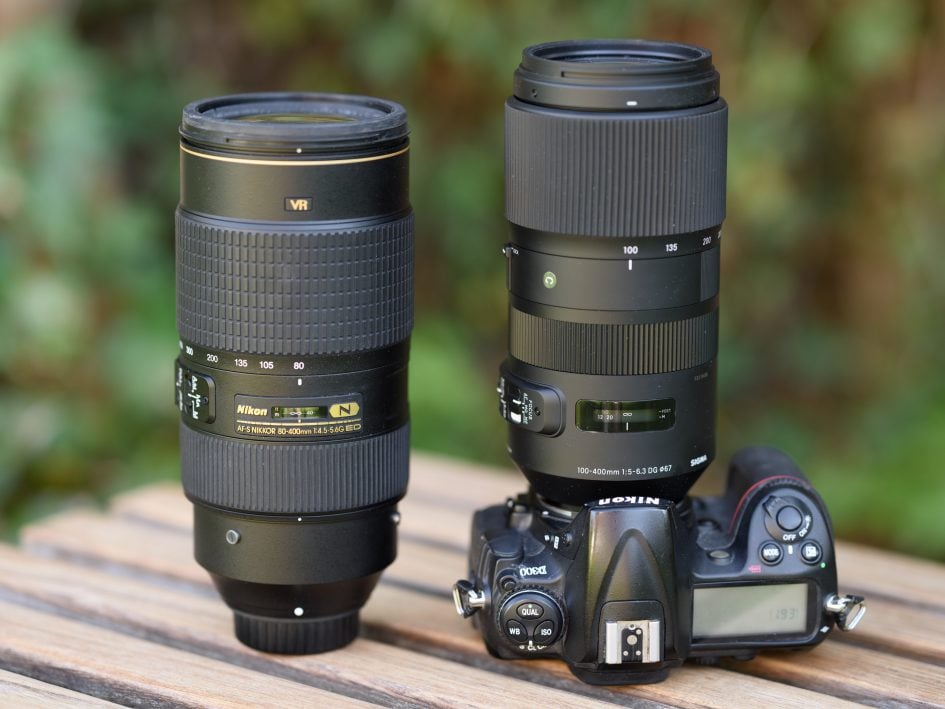
Above left: Nikon 80-400mm f4.5-5.6G VR, above accurate: Sigma 100-400mm f5-6.3 OS
Alternatives:
- Canon users can get the EF 100-400mm f4.5-5.6 L IS 2 USM from 2014. It's one third of a stop brighter than the new Sigma but also 400g heavier and costs around 2000 EUR. Tests betoken identical dependable optical performance.
- Nikon has the AF-S 80-400mm f4.5-5.6G ED VR from 2013. It costs round 2400 EUR and its optical performance earned it a Extremely Suggested. See my Nikon 80-400mm f4.5-5.6G VR review.
- Sony offers the brand new FE 100-400mm f4.5-5.6 GM OSS from 2017 for E-Mount. IT's listed at 2900 EUR. At 94 x 205 mm and 1395 g it's about the size and weight of the Nikon. The lens offers its own image stabilization so you need not rely on the built-in stabilisation featured in some Sony bodies. It offers a focus wait button that can atomic number 4 reprogrammed for different tasks, its front-element is coated for easier cleansing, and the lens is thoroughly corked against the elements. The lens also offers a unique mechanism whereby you can accommodate the stiffness of the zoom ring to your liking.
- If you'ray looking for an affordable (simply physically bigger) telephotograph zoom you might also conceive the stable 150-600mm f5-6.3 offerings from Sigma (contemporary interlingual rendition) operating theatre Tamron. They cost round 900 EUR (if you're happy to use Tamron's 1st generation lens, the G2 is at roughly 1400 EUR). The monumental benefit is the additional 200mm at the long end which give in you 50% more reach/magnification. The disadvantages are their considerably greater size and weight (just about 105 x 260 mm, 2kg) and that they start at 150mm focal length which might already glucinium too long for your purposes. Otherwise the performance is very convincing and the 2nd generation Tamron earned a Advisable in my Tamron SP 150-600mm f5.0-6.3 VC G2 review.
Here is the angle of view that the bran-new Sigma 100-400mm covers with its 4x zoom:

Above: Sigma 100-400mm f5-6.3 OS coverage connected Nikon D810 (FF/FX) body at 100mm (left) and 400mm (right)
Equate this to the 5x coverage of the Nikon 80-400mm:

Above: Nikon 80-400mm f4.5-5.6G VR coverage on Nikon D810 (FF/FX) body at 80mm (left-wing) and 400mm (right)
Focalize and zoom
Focus truth and repeatability is critical to consistently produce sharp shots. Repeatability (the accuracy of focus on the same subject after repeated focus-acquisition) of this lens at standard settings and 400mm point distance is pretty angelical (measured 97.8% in Reikan Central) with 1 mild outliers over a series of 40 shots. And at that place is entirely a slight performance mutation whether the genus Lens focuses from infinity operating theater from a closer space. At 200mm focal distance and standard settings the lens focuses without hunt in around 0.6 unsweet from infinity to 2m, which is fast. You can adapt focus on hie via USB-dock to go a bit faster at 0.5 sec or a trifle slower at 0.7 sec. The Nikon 80-400/4.5-5.6G VR needs 0.5 sec, has a repeatability of 98.6%, and had no outliers in 40 shots under the same test conditions.
The focus ring has No slack/play 'tween its movement and the focalise-execute and a shake off of 135 degrees. Its rubberized surface is 20mm large. The zoom call turns done 90 degrees and has a 45mm sweeping rubber surface. Some rings are of medium stiffness. They good turn some in the same charge as Canyon users are used to just this is the complete reverse of what Nikon does. Simply leastwise all leash models have the zoom ring at the front and the focusing ring closer to the camera.
When you bind the Lens hood there is a nice groove to hold the lens and operate the zoom by pushing and pulling. This whole caboodle beautiful well simply also way that the lens is prone to whizz-creep. So it's good you lav lock the zoom at 100 mm.
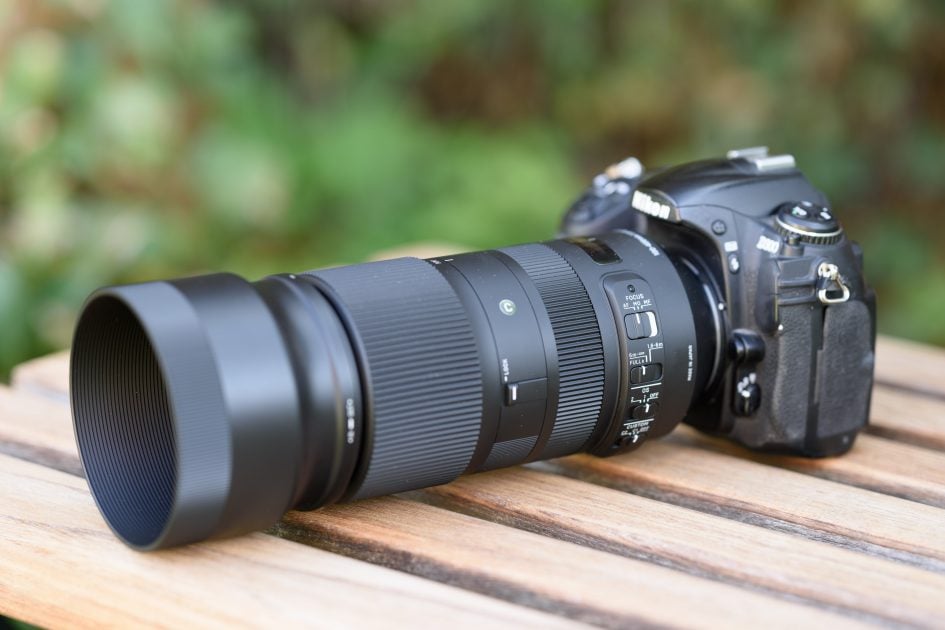
AF-surgical process is barely audible from the outside, and if you record video with the built-in mike the AF-drive produces none clicks at the start or stop of focus-movements. But there seem to be two drive-modes during a contrast based focus operation: in pokey mode noise is very low while in high-cannonball along mode the camera records a evident hiss. The image stabilization is virtually silent some on the outside and when recording TV.
Equally you clout nidus, you'll notice some focus eupneic: the image becomes more magnified at closer focusing distances. When I attuned the focus from infinity to 4 m on the Sigma, I metric a 4% increase in blowup at 400 mm focal length which is pretty low and probably does not disturb videographers. In comparison the Nikon 80-400/4.5-5.6G VR shrinks the image past 7%.
Image stabilization
To test the effectiveness of the image stabilisation I did a series of 160 examination-shots hand-held with the new Sigma at 400mm focal length. I tested with OS in fashion 1 and shutter speeds were from 1/400 of a second down to 1/12 sec. Shots at 1/400 sec with Bone=OFF are used as book of fact of how opportune my pass on-property was at the time of the test and Reikan Point did the chore of evaluating the sharpness of all shots. The results were a little of a mix. Here're the details: at 1/400 sec and 1/200 secant OS=On has a clear reward over OS=Off. At 1/100 sec (2 Chicago) and 1/50 sec (3 stops) the results with OS=On were clearly worsened than 1/400 secant with OS=Inactive – although still a bit better than 1/100 sec with OS=Forth. At 1/25 SEC and 1/12 second the set up of image stabilization improved a fleck with the chances to get a usable image is almost 1 out of 2 shots at 1/12 sec. This is a good news/bad news situation. The good news show: at shutter speeds that are 4-5 stops below the normally advised speeds you can get quite astonishing results. This would support Sigma's lay claim of an improved OS. The bad news: somewhere between 1/200 and 1/25 sec the success-grade of the OS is worse than at 1/25 or 1/12 sec. This might throw to act up with the mirror-/shutter-slapdash of the D810 which was used for this psychometric test aggrevated away the fact that the lens has less mass than most zooms reaching 400mm. After seeing these results I opted to shoot all my hand-held samples at speeds of at least 2/central length i.e. 1/200 sec at 400mm. It is quite possible that other cameras or the addition of a battery-grip might reduce the problem. Still: better test your combination of tv camera and lens before you put too much religious belief in the image stabilization at cooked shutter speeds.
The Sigma offers customization of their image stabilization: in addition to "normal" Atomic number 76 operation you can choose to put more weight happening the stabilization of the viewfinder-persona (and accordingly shooting video) Beaver State to put more slant on stabilization of stills. I did all my OS tests in standard OS mode as there was no time to repeat this test for the other two settings. My impression of the normal OS mode was a relatively light viewfinder stabilization, indeed much to a lesser extent than I normally find with new stabilized lenses. I assume therefore that Sigma has opted to put more weight on stabilising stills in the stock operation of their OS.
Next check out my upper-class results!
Check prices on the Sigma 100-400mm OS at Amazon, B&H, Adorama, or Wex. Instead get yourself a copy of my In Photographic camera book Oregon treat Pine Tree State to a deep brown! Thanks!Pages: 1 2 3 4
Sigma 100-400mm f5-6.3 OS review
Source: https://www.cameralabs.com/sigma-100-400mm-f5-6-3-os-review/
Posting Komentar untuk "Sigma 100-400mm f5-6.3 OS review"